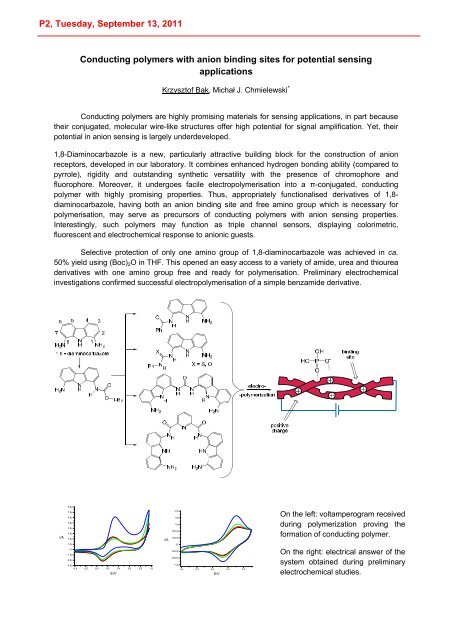International Summer School PROGRAM - Laboratoire d'Infochimie ...
International Summer School PROGRAM - Laboratoire d'Infochimie ...
International Summer School PROGRAM - Laboratoire d'Infochimie ...
Create successful ePaper yourself
Turn your PDF publications into a flip-book with our unique Google optimized e-Paper software.
Conducting polymers with anion binding sites for potential sensing<br />
applications<br />
Krzysztof Bąk, Michał J. Chmielewski *<br />
Conducting polymers are highly promising materials for sensing applications, in part because<br />
their conjugated, molecular wire-like structures offer high potential for signal amplification. Yet, their<br />
potential in anion sensing is largely underdeveloped.<br />
1,8-Diaminocarbazole is a new, particularly attractive building block for the construction of anion<br />
receptors, developed in our laboratory. It combines enhanced hydrogen bonding ability (compared to<br />
pyrrole), rigidity and outstanding synthetic versatility with the presence of chromophore and<br />
fluorophore. Moreover, it undergoes facile electropolymerisation into a π-conjugated, conducting<br />
polymer with highly promising properties. Thus, appropriately functionalised derivatives of 1,8diaminocarbazole,<br />
having both an anion binding site and free amino group which is necessary for<br />
polymerisation, may serve as precursors of conducting polymers with anion sensing properties.<br />
Interestingly, such polymers may function as triple channel sensors, displaying colorimetric,<br />
fluorescent and electrochemical response to anionic guests.<br />
Selective protection of only one amino group of 1,8-diaminocarbazole was achieved in ca.<br />
50% yield using (Boc)2O in THF. This opened an easy access to a variety of amide, urea and thiourea<br />
derivatives with one amino group free and ready for polymerisation. Preliminary electrochemical<br />
investigations confirmed successful electropolymerisation of a simple benzamide derivative.<br />
i/A<br />
8.0µ<br />
7.0µ<br />
6.0µ<br />
5.0µ<br />
4.0µ<br />
3.0µ<br />
2.0µ<br />
1.0µ<br />
0.0<br />
-1.0µ<br />
-2.0µ<br />
-3.0µ<br />
-0.4 -0.2 0.0 0.2 0.4 0.6 0.8 1.0<br />
E/V<br />
i/A<br />
2.0µ<br />
1.6µ<br />
1.2µ<br />
800.0n<br />
400.0n<br />
0.0<br />
-400.0n<br />
-800.0n<br />
-1.2µ<br />
-0.4 -0.2 0.0 0.2 0.4<br />
E/V<br />
On the left: voltamperogram received<br />
during polymerization proving the<br />
formation of conducting polymer.<br />
On the right: electrical answer of the<br />
system obtained during preliminary<br />
electrochemical studies.









